A striking representative of the new cocktail type is the “Easter Egg” tomato: a full review
Cocktail tomato varieties are rapidly gaining fans among discerning gourmets and experienced gardeners. The former like the appearance and taste of the fruit, the latter – the process of cultivating the crop. A juicy ripe tomato during the harvest period becomes the main prize, a source of pride and a measure of agricultural excellence.
Among cocktail varieties, the Easter Egg lives up to its festive name. Its fruits have a regular ovoid shape with a bright red-yellow color. In the photo they resemble works of art, as if they were not a creation of nature, but the famous Easter egg from Carl Faberge.
Description of the variety
Cocktails stand out among other varieties primarily due to their appearance.. They represent a new direction in tomato breeding, which came to Russia from Europe.
The name reveals the purpose of the vegetable - to decorate the table at buffets and cocktail parties. Most of our compatriots are well aware of cocktail cherry tomatoes. When pickled, these tomatoes have already become a favorite snack.
By the way. The Easter Egg variety was created by breeders for open ground, but in the conditions of central Russia and the Moscow region it is recommended to grow it in a greenhouse.
Distinctive features
The Easter egg variety is not as popular as the cherry variety, but thanks to its advantages it has every chance of becoming a favorite in the cocktail line.
Firstly, due to its decorative properties - its fruits are bright and attractive.
Secondly, the variety has undeniable consumer advantages - a specific aroma and a sweet and slightly sour taste, high density and keeping quality. And thirdly, this variety is quite suitable for cultivation even by novice gardeners.
Features of the variety:
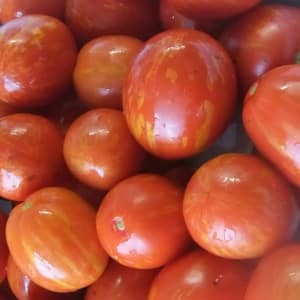
- indeterminate, the plant can reach 1.6-1.8 m in height, which leads to high yield per unit area;
- equally good for growing both in a greenhouse and in open ground;
- begins to bear fruit early, on the 110th day after planting;
- resistant to diseases and is immune to many viruses, including tobacco mosaic virus;
- unpretentious in care compared to other varieties of tomatoes.
Fruit characteristics and yield
The fruits of the Easter Egg variety cannot be confused with others - they are egg-shaped and red with yellow stripes.
Tomatoes ripen in clusters of 5-7 pieces, the weight of each varies between 60-90 g. On average, 5-7 kg of fruit can be collected from a bush per season.
How to grow seedlings
Because Easter Egg is a variety and not a hybrid, its seeds are sold unprocessed. You will have to independently provide your crops with protection from rot and mold.
The seeds are sown 45-60 days before transplanting the plants to a permanent place in the beds, where they will grow for another 1.5-2 months. Calculate the timing in advance, taking into account the climatic features of a particular area.
Seed preparation
The seeds are soaked for 20 minutes in a 1% solution of potassium permanganate, then washed and immersed in any growth stimulator.This can be aloe juice diluted 1 to 1 with water, a solution of honey (1 teaspoon per glass of warm water) or special formulations: “Epin”, “Gumate”, “Energen”.
Reference. "Epin" is one of the most effective seed growth stimulators. Since this is a concentrate, use it with extreme caution. For germination, dilute 3 drops of the drug in 100 ml of water. In the future, it is also used for spraying seedlings. Concentration: 6 drops per 0.5 liters of water.
Seeds are sown without waiting for them to peck, after being kept in a growth stimulator for 12 hours to 24 hours. Plants treated in this way sprout quickly, do not suffer from blackleg and are resistant to being pulled out.
Container and soil
Shallow trays are prepared for seedlings. Fill them with purchased or self-prepared substrate. It is quite simple to prepare: add one part of turf soil and compost and half a part of sand to 2 parts of peat.
It is recommended to add one glass of wood ash and a complex fertilizer of phosphorus, potassium and nitrogen to a bucket of this mixture. Such soil contains all the macro- and microelements necessary for the normal development of plants.
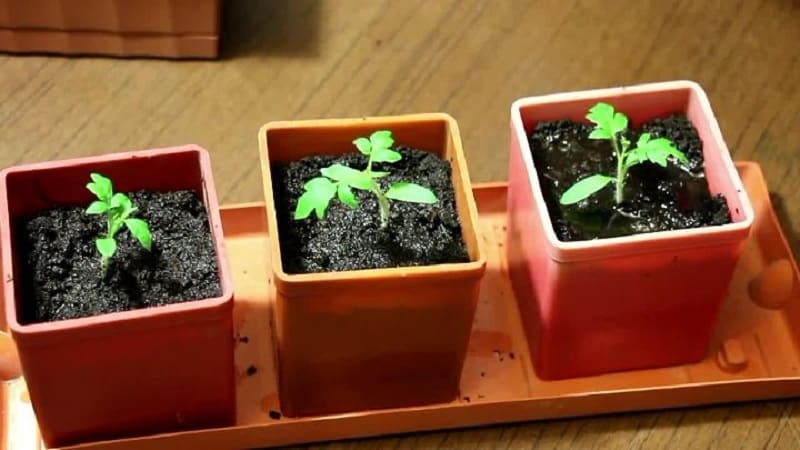
Important! Ready-made substrate for cultivation can also be purchased at a specialized store. It is usually packaged in paper bags marked “for tomatoes and peppers.”
Sowing
The sowing depth should not exceed 1.5 cm, and the width between the grooves should be at least 3 cm. The seeds are sprinkled with earth and watered abundantly, then covered with film. In the future, they must be ventilated at least once a day. The optimal temperature for germination is 22–25° C.
Growing and care
The film is removed after germination. The boxes are moved to a well-lit place.When the sprouts have formed 2-3 leaves, it’s time to start picking. As carefully as possible, so as not to damage the barely formed root system, the seedlings with small pieces of soil are moved into individual containers. Peat pots are ideal for this.
Transfer of planting material to a permanent place is carried out after hardening the plants for 1 week. The seedlings are taken out into the open air, gradually increasing the time from 20 minutes to 2 hours a day.
How to Grow an Easter Egg
The agricultural technology for growing the variety is the same as for other varieties and hybrids of indeterminate type tomatoes. Tall bushes will require special care throughout the growing season.
Important! For favorable growth, trellises are required - supports for tying up bushes. Each bush also needs timely leveling and pinching.
Landing
Transplantation to a permanent place is the next crucial moment. Time - one and a half to two months before the expected start of harvest. Depending on the geographical location and climatic characteristics of the area, planting dates range from the second half of May to the beginning of June.
Depending on the specific conditions, as well as on the experience of the farmer and his readiness for the vicissitudes of the weather, the location is chosen: in a greenhouse or in open ground. Areas where potatoes, peppers, tomatoes and other nightshade crops were cultivated in previous seasons are unsuitable for planting. After these crops, the soil is significantly depleted of the necessary macro- and microelements.
Light soil types with pre-drainage are more suitable for planting. It is advisable to disinfect the soil by treating it with a 1% solution of potassium permanganate.Planting is carried out in recesses the size of peat pots on pre-formed beds, the width of which is 80 cm and the height is 30 cm.
Important! It is recommended to add complex organomineral fertilizers to the holes. For example, the already mentioned “Gumat”, which, in addition to stimulating seed growth, has proven itself well as a top dressing when transplanting seedlings into the ground and subsequent care of seedlings.
Plants are placed in parallel or in a checkerboard pattern - it doesn’t really matter. Simultaneously with planting, supports or trellis structures for gartering bushes are installed. Doing this later is not recommended so as not to damage the roots.
Care
Seedlings should be watered moderately with settled warm water, weeded and the top layer of soil around them regularly loosened to prevent root rot.
If you carry out mulching - lay a layer of dried grass, straw or black non-woven fiber around each plant - the number of waterings and loosening can be reduced. The mulch layer should be at least 5 cm thick.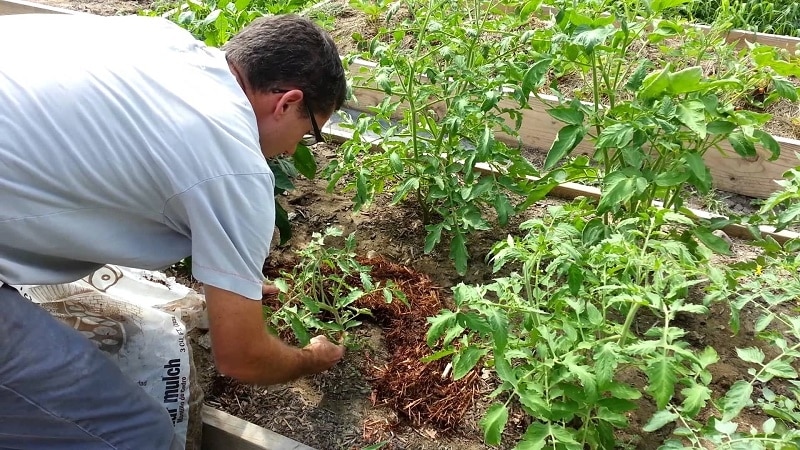
Requires more attention and labor stepsoning and formation of bushes. Timely removal of leaves and excess shoots allows the plant to mobilize all the resources of nutrients for ovary and fruit growth. Therefore, the bush is usually formed into only two stems.
As the plant thus formed is stretched, its stems are tied to supports and trellises. Garter, like pinching with pruning, is carried out throughout the entire growing season. They are also regularly fertilized with complex mineral fertilizers.
Attention! Even if the area for tomatoes is properly prepared, with the preliminary application of organic fertilizers to the soil, normal growth will only be ensured by periodic fertilizing with mineral fertilizers. The soil requires a whole complex of minerals: calcium, boron, magnesium, manganese, zinc, sulfur and others. But the most important components are 3 minerals: nitrogen, phosphorus and potassium.
It is necessary to select fertilizers in such a way as to compensate for the lack of certain mineral elements - one, two or several at once. The deficiency of one or another element can be judged by the appearance of the plants.

Here are the special signs of deficiency:
- nitrogen - yellowed leaves, elongated stems, the trunk becomes soft, and the veins on the underside of the leaf acquire a bluish tint;
- phosphorus - the stem becomes stiff and brittle, and the leaves curl inward, the color of the plant changes to purple;
- potassium - the leaves darken, curl into a tube, and brown spots appear along the edges, forming a border.
Compose feeding You can do it yourself or purchase it ready-made in the form of a complex fertilizer. Energen, which is not produced on the basis of coal, has proven itself well, which is why it is quite rightly classified as a fertilizer of natural origin. It contains microelements based on sulfur and potassium salts of humic acids. It has an excellent effect on the active growth of plants throughout the growing season, increases productivity and increases fruiting time.
Important! When applying complex fertilizers, strictly adhere to the dosages and recommendations indicated on the packaging.
Features of cultivation and possible difficulties
The Easter Egg variety does not have any exceptional growing features that are different from other indeterminate type tomatoes. This process will not cause any difficulties even for novice amateur gardeners.
The main thing is to strictly adhere to a well-developed scheme, observing the order and timing of all manipulations with plants:
- From the moment of sowing the seeds until the seedlings are transferred to the ground, at least 60 days must pass.
- It is necessary to carry out pinching and formation of the bush in time.
- Depending on the condition of the plants, fertilize periodically.
Carefully! During the flowering period, you should not fertilize with nitrogen-containing fertilizers.
Diseases and pests
The variety is resistant to most tomato diseases. This circumstance is noted by almost all gardeners who cultivated the Easter egg. Even to the eternal scourge of all nightshades - the tobacco mosaic virus. The variety also successfully resists many pests.
Due to excess moisture at low temperatures, blackening of the fruits is possible. Emergence late blight can be prevented by selecting a well-ventilated and sunny place for planting. If necessary, use a fungicide.
Reference. Among the variety of fungicidal preparations, one can highlight Oxychom, which perfectly protects tomatoes from late blight. This is a powdered fungicide for spraying plants. Before use, it is diluted in water in the following proportion: 20 g per 10 liters of water.
The nuances of growing in open ground and in a greenhouse
This tomato variety was bred for cultivation in open ground. This is exactly how it is cultivated in the southern regions of Russia with a relatively mild and, most importantly, predictable climate.The nuances here come down to ensuring a supply of warm, settled water for irrigation, as well as effective drainage of the beds in case of prolonged or heavy rains. Of course, care should also be taken to ensure the reliability of the supports so that they can withstand gusty winds and erosion.
In regions located to the north, it is advisable to grow Easter eggs under film. Even in the Moscow region or central Russia, it is worth protecting these generally unpretentious tomatoes from hail, hurricane winds and other vagaries of nature.

Wherein you need to carefully monitor the temperature and humidity levels in greenhouses. The soil must not be over-moistened. Periodically ventilate and loosen the soil. One more nuance: in the greenhouse you should not overuse mulching to avoid mold and rot.
Harvesting and application
Easter eggs usually begin to fructify at the end of July. Ripening in clusters of 5-7 pieces continues until the first frost. Thus, for about a month, fresh tomatoes can be served directly from the garden to the table served for a buffet or cocktail. The excellent taste of these festively bright tomatoes is noted by almost everyone who has had the chance to try them: dense, meaty, sweet with a slight sourness and a specific tomato aroma. Many people note that by the end of the season the fruits become smaller and sweeter.
Interesting. Easter egg can rightfully be called a universal variety due to its compactness, decorativeness and keeping quality.
Small tomatoes are suitable for whole-fruit canning. The dense skin is resistant to cracking and mechanical damage, so the fruits tolerate transportation and long-term storage in a cool and dry place.But in terms of juice or paste production, the Easter egg is inferior to large-fruited tomato varieties.
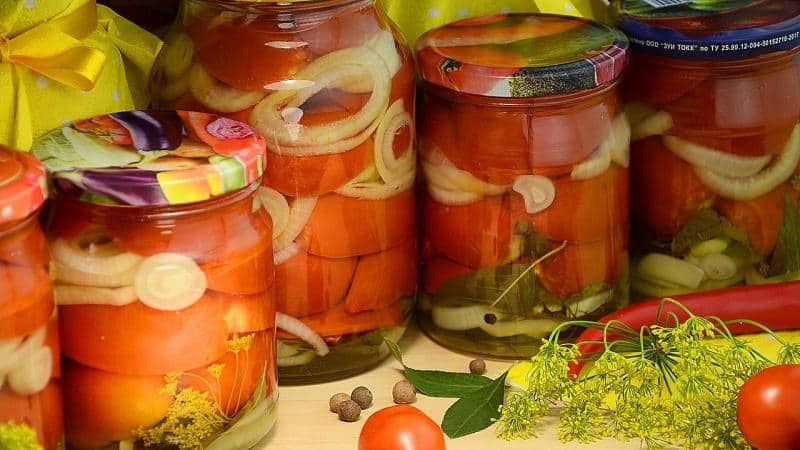
Advantages and disadvantages of the variety
The benefits of the Easter Egg cocktail variety of tomatoes include: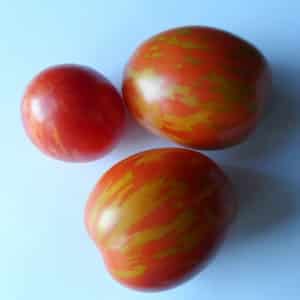
- excellent taste and attractive appearance;
- short ripening period;
- long fruiting period;
- high productivity;
- resistance to diseases and pests;
- versatility - suitable for fresh use and canning.
The variety is relatively labor-intensive during the growing season when grown in the ground. Requires regular gartering, pinching and pruning. Perhaps this is its only drawback.
Farmer reviews
Natalya Ivanovna, Moscow region: “I raised an Easter egg only once – last year. Among the positive qualities are high shelf life and the ability to transport. I needed exactly them, because I sell tomatoes. The variety interested my clients. They were pleased with the taste. In general, this is one of the best options for private businesses.”
Alexander Sidorov, Balashikha: “I grew the Easter Eggs variety from seeds and planted the seedlings in a greenhouse. I would like to note the high productivity of the bush, beautiful aromatic fruits. The tomatoes are small, the flesh is juicy raspberry in color and has an unusually sweet taste. I used it fresh and rolled it up.”
Nina Samoilova, Krasnodar: “A friend recommended Easter eggs. I grew tomato bushes in the garden without special shelter. The plant was very strong and the extra branches had to be removed. The fruits are amazingly colored: yellow stripes on a red background. The pulp is juicy and delicate in taste. I was pleased with the harvest."
Conclusion
In conclusion, we can state: Easter Egg is, although a new, but very promising variety of tomatoes, a genuine achievement of breeders. It is relatively easy to care for. It can be grown both in a greenhouse and in open ground.
The variety is universal in terms of using the harvested crop. You should try the Easter egg in your garden, and then check out the taste and color!